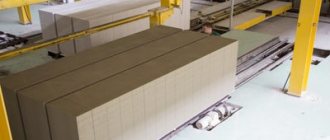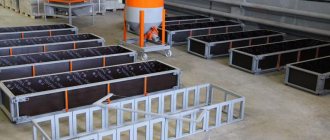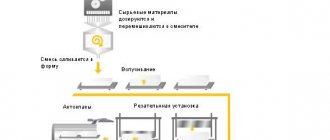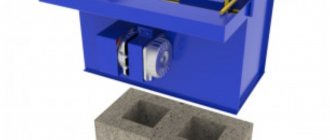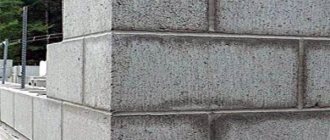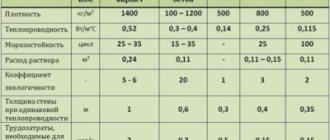In the 60s of the last century, when the production of autoclaved concrete was developing, there were different methods for their production. Some of them involved the use of cement, others - lime, and others - mixed binders. In those years, the term “gas silicate concrete” was widespread, which is still used today - but erroneously: silicate cellular concrete is a thing of the past as a class. The industry of the 21st century does not produce pure gas silicates - today more durable concretes based on cement and mixed binders are common. Therefore, those who nowadays say “gas silicate” in most cases mean autoclaved cellular aerated concrete.
Over the past 15 years, the average annual housing commissioning in Russia has increased 2.5 times. Over the same period, the production of autoclaved aerated concrete increased 12 times. It has become the most widely used wall material used in construction.
In recent years, the popularity of aerated concrete blocks has been growing - in particular, low-density grades, for example, D350. It is worth noting that today in Russia more than 1.5 million m3 of low-density blocks are produced annually. The question is increasingly being asked: how is this material produced? A detailed answer to it is in this article.
Molding
From the mixer, the raw materials enter large-volume molds. Here the mixture is kept for several hours at a temperature of approximately 50º C. The reaction takes place and the mass rises, resembling yeast dough. A huge number of cells (pores) appear, which give the building material its name. After the mass has acquired the required volume, some more time is needed for it to pre-harden. Next, it is turned 90º and placed in a vertical position on the autoclave tray. Here the mass remains during cutting, autoclaving and separation.
At the end of the process, the mixture is fed to the cutting section.
Composition of aerated concrete blocks
All of the listed advantages of this building material are due to its composition. All that aerated concrete consists of is cement, quartz sand and a gas-forming agent, which is aluminum powder. Some manufacturers add gypsum, lime, ash, and other ingredients to the composition.
Thus, aerated concrete is made on the basis of dry components that are mixed with water. Any technical clean water that meets the requirements of GOST 23732-79 is suitable for these purposes. The temperature of the water is important. It is desirable that it should not be lower than 45°C, since this will speed up the hardening of the blocks, increase their strength, and for the enterprise this is beneficial because it will increase the productivity of the line as a whole. Thus, many manufacturers heat the water because higher temperature means better quality material. It also helps reduce the amount of cement used, since heating the water stimulates the activity of the dry components of the mixture.
The production of aerated concrete requires a rather serious approach to the choice of sand. Theoretically, both quarry and river sand are suitable for these purposes, but it is important that it contains as few silt or clay particles as possible. It is also important to choose the grain size - no more than 2 mm. The technology for producing aerated concrete using the autoclave method makes it possible to replace sand with slag or ash obtained from metallurgical production. Thermal power plant ash helps produce aerated concrete with a lower density. This helps further reduce material production costs.
For the production of aerated concrete blocks, Portland cement grades M400 and M500 are required. It is best that Portland cement meets the requirements of GOST 10178-85. But the aluminum powder should be grade PAP-1 or PAP-2 - it acts as a gas generator. Sometimes a special paste is used for the same purpose. It can also be a suspension, since powdered aluminum is not so convenient when mixing the solution. Suspensions based on it can also be used.
What is the effect of aluminum powder based on? It reacts with cement or lime mortar, which has alkali properties, and during this chemical process, calcium salts (aluminates) and hydrogen gas are formed, which ensures the formation of pores.
For the production of aerated concrete, it is very important to make the correct calculation of the consumption for each component of the feedstock. There are standard recommendations for autoclaved gas blocks. Based on this recipe, the entire volume of the mixture is filled with 50-70% cement, 0.04-0.09% aluminum powder and up to 20-40% sand. In addition, you will need water (0.25-0.8%) and lime (1-5%). Thus, in order to get 1 cubic meter of aerated concrete, you need to take up to 90 kg of cement, up to 300 liters of water, lime - 35 kg, sand - 375 kg, aluminum powder - 0.5 kg. But this quantity can be adjusted under the conditions of a specific production, depending on the quality characteristics of the raw materials themselves.
Autoclaving
The cut blocks are placed in an autoclave - a chamber with a temperature of 180-190ºC, a pressure of about 12 bar and saturated steam. Here the future building material is aged for 12 hours. During this time, a crystalline structure is formed in the blocks, which distinguishes autoclaved aerated concrete from other materials and gives it decent practical properties.
After processing in an autoclave, the finished building material is laid out to cool using a divider tap.
Business benefits and possible risks
The production of aerated concrete as a business has many advantages. For example:
- the project quickly pays off;
- products are in demand;
- you can start with a relatively small amount of investment – from 1,500,000 rubles;
- high profitability and profitability.
The main disadvantage of business is the high level of competition. In Russia, the production of aerated concrete has long been established; many companies are successfully developing in this direction. Those who plan to open a mini-enterprise for the production of aerated blocks should take into account the possible risks of the project:
- an increase in the cost of raw materials, which will entail an increase in the cost of products;
- increases in rent and utility costs;
- development of new building materials, the quality characteristics of which will exceed the properties of aerated concrete;
- emergence of new competitors.
Distinctive features of the equipment used
To produce autoclaved cellular aerated concrete, our plant uses HESS AAC Systems BV equipment that meets the most stringent international standards.
Bulk materials supply system. It uses patented Lahti Precision technology, implemented only in HESS lines, which is based on fluidization of materials. The system unloads the silo and meters the supply of bulk materials in a fluidized state created by air. Augers and other mechanical parts are not used, so there is no need to clean or replace parts. The most important thing is that the system allows you to dose bulk materials with an accuracy of up to 100 grams. This makes it possible to adapt the recipe as accurately and flexibly as possible.
Array tilting device. Before cutting, the solid is turned into a vertical position in the mold, after which the mold body is removed. The array is not subjected to mechanical gripping by the manipulator, which has a positive effect on the quality of the final product. The appearance of cracks is prevented, deformation of the massif is eliminated, and the strength and geometric characteristics of the blocks are preserved.
Device for vertical, preliminary and final side cutting. Cuts the material in three dimensions, allows you to adjust the thickness of the removed layer or level the surface of the array after preliminary cutting. The line is equipped with a system that monitors string breaks. The cuttings of the massif are thrown into the sludge channel, washed with water. From here they enter a container with a grinding device and a stirrer located under the cutting line. From the tank, the sludge is transported to the sludge basin for further use. This solution saves raw materials and serves as part of the “Waste-free production” concept.
Array division system. It implements a unique technology for separating the “green” massif, which allows it to be stratified immediately after cutting - before autoclaving. The mass is fed into the autoclave divided into layers. Thanks to this, steaming is carried out as evenly and efficiently as possible, and aerated concrete acquires the maximum possible strength. Unlike traditional technologies, which involve cutting a vertically standing mass and separating the “white” product, the layers do not stick together during steaming. Therefore, additional separation of blocks after autoclaving is not required. Thanks to this, the attractive appearance of the blocks is preserved, the appearance of chips, holes and cracks is eliminated, and the ideal geometry of the final product is ensured.
The importance of choosing the right ingredients
If you overdo it with some components, the mixture will not be so durable , soundproofing and with good thermal insulation and environmental friendliness.
And if you do not add some component, for example, a gas generator, then the gas block will not acquire its porous structure and will not have thermal insulation properties.
The introduction of a blowing agent into the mixture must be strictly controlled.
Otherwise, if you reduce the dosage by only 0.06%, then the blocks will not achieve the required density and strength, and if you add 0.1% more, then during the reaction there will be an excess of hydrogen released, as a result of which the pores will become huge, and the block itself immediately after hardening it will shrink significantly.
What documents are needed to open
It is necessary to register a business entity: most often it is an individual entrepreneur. If you plan to sell materials through large companies, then it is recommended to register a limited liability company. The prepared documents are submitted to government authorities or to multifunctional public service centers (MFCs). It is also necessary to register with the Pension Fund, Social and Health Insurance Fund. To make payments to legal entities, you must open a bank account.
Requirements for production premises
The room allocated for the production of gas silicate blocks with your own hands must meet certain requirements. To store raw materials and finished products, you will need a specially designated place. The height of the room must be at least three meters.
Also, tech. the process requires the presence of 380V and 220V electrical networks, water supply and access roads. The room itself must be insulated and cleaned of dirt and debris.
The production of gas silicate is considered waste-free, so there is no need for sewerage on the territory of the mini-plant.
Cost calculation
Necessary materials and equipment
Materials:
- cement – about 4 thousand rubles/ton;
- aluminum paste - 6 thousand rubles/kg.
- quartz sand – about 1.5 thousand rubles/t.;
- quicklime – from 3 thousand rubles/t.;
Equipment:
- fur. sieve - from 30 thousand. rub.;
- mill – from 600 thousand rubles;
- mortar mixer - from 40 thousand rubles;
- autoclave – about 1 million rubles;
- dispensers - from 40 thousand rubles;
- molds for blocks - about 50 thousand rubles / piece;
- cutting template with a set of saws and/or milling machine;
- forklift;
- steam generator with steam pipeline - about 400 thousand rubles;
- various containers.
Payback
The cost of production is 2200 rubles per 1 cubic meter. m. taking into account the cost of materials and electricity consumption (about 500 rubles per 1 cubic meter of product).
The cost of the material on the market ranges from 3,000 to 4,000 rubles. Production may well pay for itself in 4 to 6 months.
Material Specifications
Gas silicate blocks are a high-quality building material. They are characterized by low cost, environmentally friendly production and low weight. These qualities have allowed the material to gain wide popularity in the construction industry.
The blocks have high strength, and thanks to the cellular structure, gas silicate can have a density from 300 kg/m³ to 700 kg/m³, evenly distributed throughout the block, which also increases the popularity of this product among construction companies.
Search for aerated concrete sales channels
The most difficult stage of organizing a business is finding distribution channels for gas blocks. For production to operate at full capacity, you need to constantly sell products. Finding buyers is not so easy - most development companies already cooperate with other suppliers of building materials.
You can advertise your products in different ways:
- Post advertisements at the entrance to cottage communities under construction and at the exit from the city;
- advertise in newspapers;
- place advertisements for the sale of aerated concrete on free and paid platforms on the Internet;
- contact developers directly and offer them products at a competitive price;
- create a website and promote it.
The peculiarity of the business is seasonality. The demand for building materials increases in the warm season. This factor must be taken into account when organizing. It’s good if production starts at the end of February – beginning of March. Then the entrepreneur will have enough time to develop regular customers.
Attention! If there are already similar enterprises in the region that produce aerated concrete, the new company should stand out favorably against their background - in terms of product quality, delivery speed, and cost of products.
Market analysis
In most European countries, the share of construction of walls of residential and non-residential buildings made of cellular concrete is 30–40%. In Russia, interest in this building material is gradually growing, but has not yet reached such levels. In our country, house construction from aerated concrete is stimulated by the following factors:
- the growing need of the population for housing, especially in settlements located near megacities;
- active development of low-rise construction in rural areas;
- tightening requirements for thermal protection of buildings.
An additional incentive is the affordable cost of aerated concrete - it is cheaper to build with it than with brick or wood. In addition, the construction of buildings made of cellular concrete occurs many times faster. For example, a team will build a residential building with an area of 100 m2 in a few days.
All these factors influence the increase in demand for the product. The aerated concrete market has been developing rapidly in recent years. Marketers predict a further increase in demand for cellular concrete due to a reduction in the volume of brick construction.
Reference. Among the CIS countries, Belarus is a leader in the use of aerated concrete. In this country, almost 40% of residential buildings are built from this material.
Financial calculations
The business plan contains information about the volume of investments, current expenses and expected income. By comparing these data, you can find out what the profitability of the project is and how quickly the investment will pay off.
Investments in the project and costs of maintaining production
Volume of investments to open production:
- registration of constituent and permitting documentation – 10,000;
- purchase of equipment – 800,000;
- payment of workshop rent for 6 months in advance – 120,000;
- preparing the premises for operation – 50,000;
- expenses for the first batch of raw materials – 750,000;
- advertising – 20,000.
Total: 1,750,000 rubles.
Every month, the business owner spends money to maintain the project. Current expenses include:
- workshop rent – 20,000;
- utility bills – 10,000;
- salary – 100,000;
- payment for accountant services – 6,000;
- raw materials – 1,300,000;
- depreciation, production line maintenance – 10,000;
- advertising – 5,000;
- tax – 15% of the difference between dirty income and expenses.
Total: 1,431,000 plus tax deductions.
Income and profit calculation, project efficiency
During 1 shift, the company produces 36 m3 of aerated concrete. The cost of 1 m3 is 1600 rubles, and the selling price is 3500 rubles. Let's do the calculations:
- The volume of production for 23 work shifts is 23x36 m3 = 828 m3.
- The company's revenue for the month is 828 m3x3500 rubles = 2,898,000 rubles.
Let's determine the net profit of the enterprise by subtracting current expenses and tax deductions from the monthly revenue: 2,898,000–1,431,000=1,467,000–220,050 (15% tax)=1,210,950 rubles.
Calculations show that even when working one shift, the company earns more than 1 million rubles of net profit per month. It is important to understand that such results can be achieved no earlier than in 3–5 months. This time is necessary to find regular customers. As soon as the workshop reaches the planned sales level - 828 m3 of aerated concrete per month, it will be possible to expand the staff and switch to shift work to produce more blocks.
The payback period of the project depends on many factors - sales volume, production line capacity, and the amount of initial investment. On average, it is 3–6 months. Business profitability is 41.78%, this indicator is calculated by the ratio of net profit to gross, multiplied by 100 - 1,210,950/2,898,000x100% = 41.78%.
Building a business in the production of aerated concrete blocks is not an idea for beginners. To implement such a project, you will need not only a large sum of money, but also skillful marketing, because the success of the event depends on the volume of products sold. In conditions of high competition, it is very difficult to find regular buyers for large quantities of aerated concrete. For successful development of the project, it is recommended to hire a competent marketer on staff.
Recommendations from experts
It should be noted that the finished product will gain its final strength and other characteristics no earlier than in 28 days.
Approximate proportion of components: sand - no more than 60%; quicklime - about 20%; cement - 20% and aluminum powder - no more than 1%. In the required proportion, all components are fed into an aerated concrete mixer, where they are thoroughly mixed to the consistency of sour cream.
When unloading the working mixture into the mold, it must be subjected to shock, this will improve the structure of the porous structure. It should be taken into account that lime slaking occurs with the release of heat; therefore, the temperature of the working mixture can reach up to 80°C in 1.5 hours.
As a conclusion: during construction work this material will naturally cost you less. In addition, in terms of thermal conductivity, aerated concrete is no worse than brick masonry (half the thickness).
